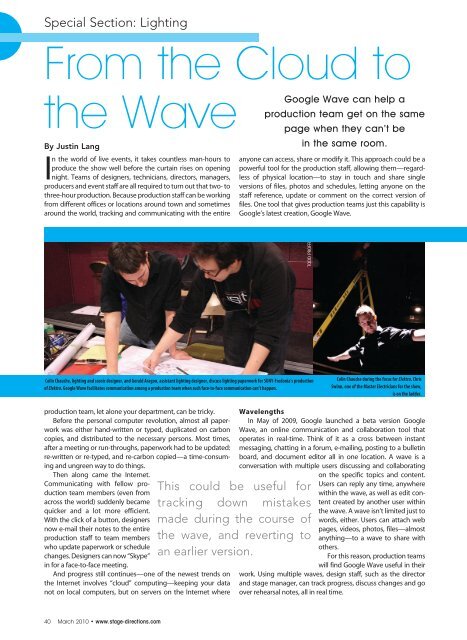Download a PDF - Stage Directions Magazine
Download a PDF - Stage Directions Magazine
Download a PDF - Stage Directions Magazine
Create successful ePaper yourself
Turn your PDF publications into a flip-book with our unique Google optimized e-Paper software.
Special Section: Lighting<br />
From the Cloud to<br />
the Wave<br />
By Justin Lang<br />
In the world of live events, it takes countless man-hours to<br />
produce the show well before the curtain rises on opening<br />
night. Teams of designers, technicians, directors, managers,<br />
producers and event staff are all required to turn out that two- to<br />
three-hour production. Because production staff can be working<br />
from different offices or locations around town and sometimes<br />
around the world, tracking and communicating with the entire<br />
Google Wave can help a<br />
production team get on the same<br />
page when they can’t be<br />
in the same room.<br />
anyone can access, share or modify it. This approach could be a<br />
powerful tool for the production staff, allowing them—regardless<br />
of physical location—to stay in touch and share single<br />
versions of files, photos and schedules, letting anyone on the<br />
staff reference, update or comment on the correct version of<br />
files. One tool that gives production teams just this capability is<br />
Google’s latest creation, Google Wave.<br />
Todd Proffitt<br />
Colin Chauche, lighting and scenic designer, and Gerald Aragon, assistant lighting designer, discuss lighting paperwork for SUNY-Fredonia’s production<br />
of Elektra. Google Wave facilitates communication among a production team when such face-to-face communication can’t happen.<br />
Colin Chauche during the focus for Elektra. Chris<br />
Swinn, one of the Master Electricians for the show,<br />
is on the ladder.<br />
production team, let alone your department, can be tricky.<br />
Before the personal computer revolution, almost all paperwork<br />
was either hand-written or typed, duplicated on carbon<br />
copies, and distributed to the necessary persons. Most times,<br />
after a meeting or run-throughs, paperwork had to be updated:<br />
re-written or re-typed, and re-carbon copied—a time-consuming<br />
and ungreen way to do things.<br />
Then along came the Internet.<br />
Communicating with fellow production<br />
team members (even from<br />
across the world) suddenly became<br />
quicker and a lot more efficient.<br />
With the click of a button, designers<br />
now e-mail their notes to the entire<br />
production staff to team members<br />
who update paperwork or schedule<br />
changes. Designers can now “Skype”<br />
in for a face-to-face meeting.<br />
And progress still continues—one of the newest trends on<br />
the Internet involves “cloud” computing—keeping your data<br />
not on local computers, but on servers on the Internet where<br />
This could be useful for<br />
tracking down mistakes<br />
made during the course of<br />
the wave, and reverting to<br />
an earlier version.<br />
Wavelengths<br />
In May of 2009, Google launched a beta version Google<br />
Wave, an online communication and collaboration tool that<br />
operates in real-time. Think of it as a cross between instant<br />
messaging, chatting in a forum, e-mailing, posting to a bulletin<br />
board, and document editor all in one location. A wave is a<br />
conversation with multiple users discussing and collaborating<br />
on the specific topics and content.<br />
Users can reply any time, anywhere<br />
within the wave, as well as edit content<br />
created by another user within<br />
the wave. A wave isn’t limited just to<br />
words, either. Users can attach web<br />
pages, videos, photos, files—almost<br />
anything—to a wave to share with<br />
others.<br />
For this reason, production teams<br />
will find Google Wave useful in their<br />
work. Using multiple waves, design staff, such as the director<br />
and stage manager, can track progress, discuss changes and go<br />
over rehearsal notes, all in real time.<br />
40 March 2010 • www.stage-directions.com

















